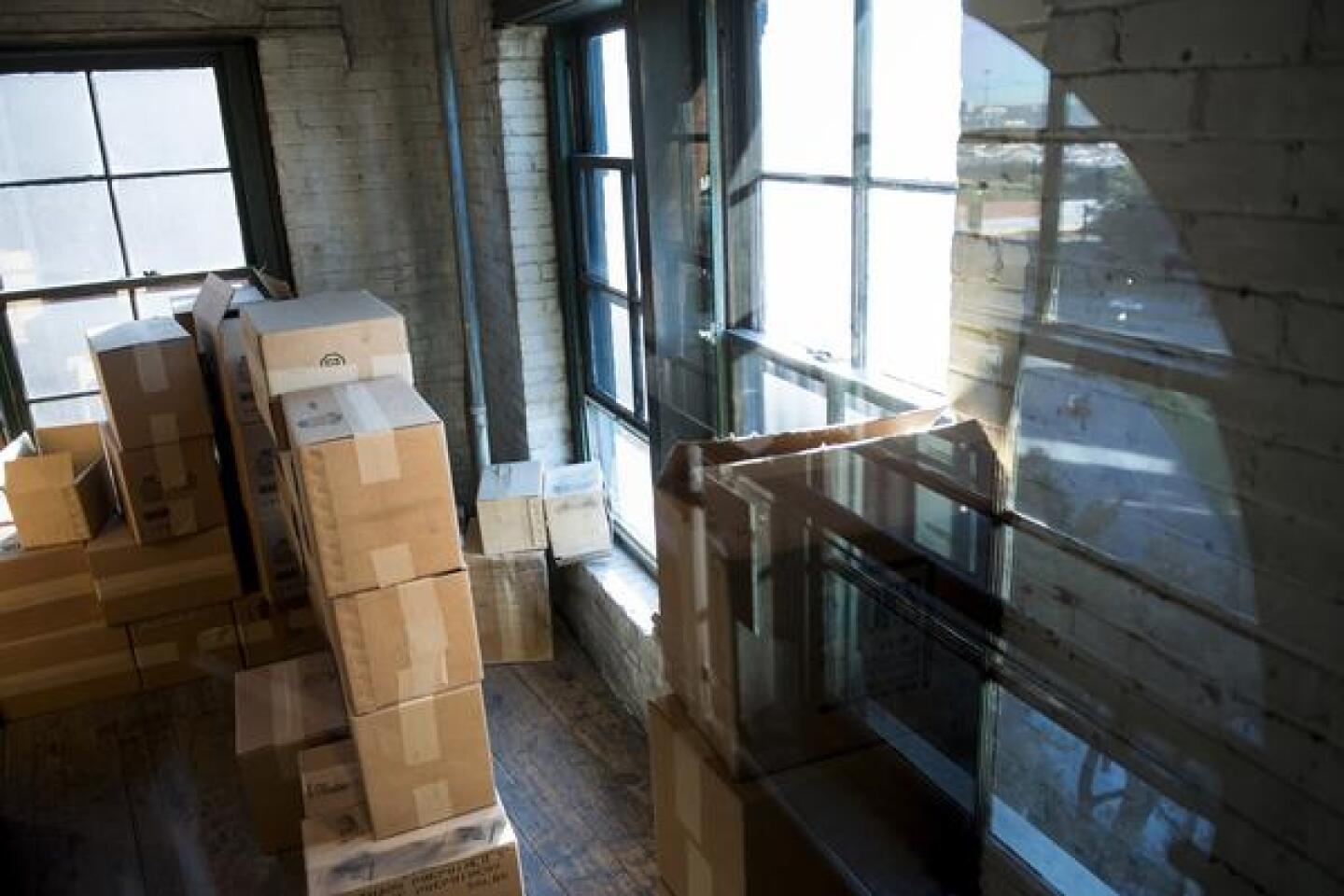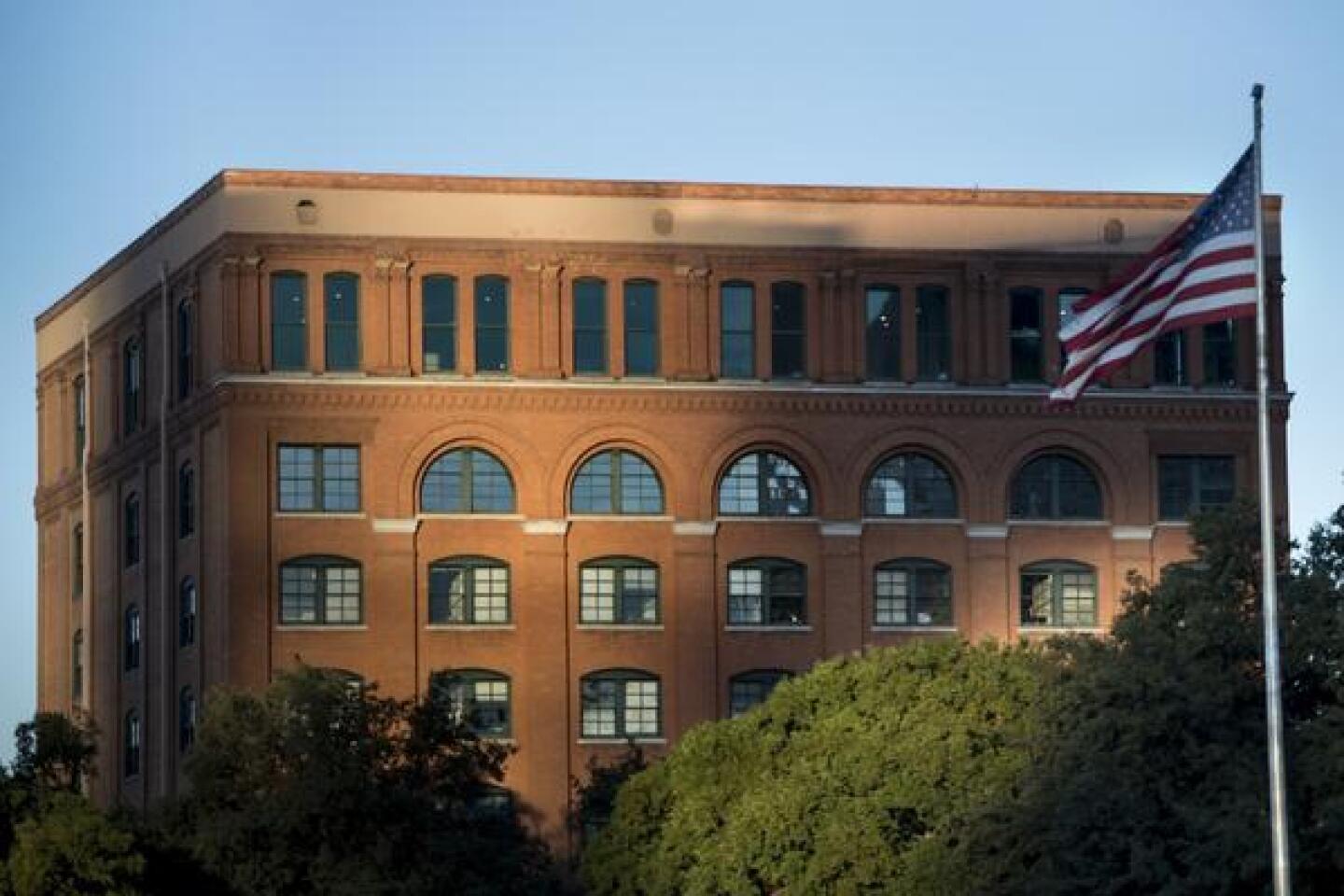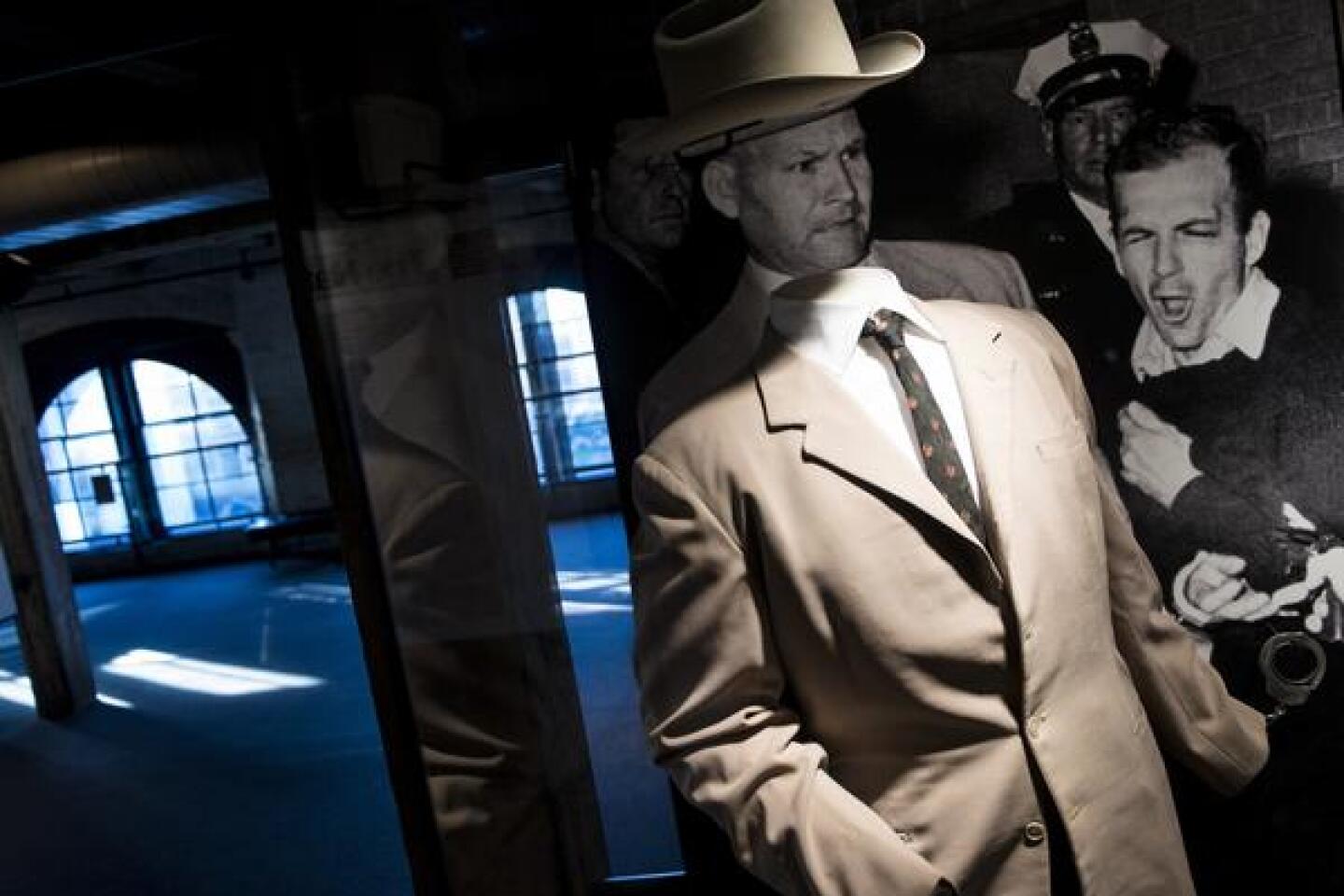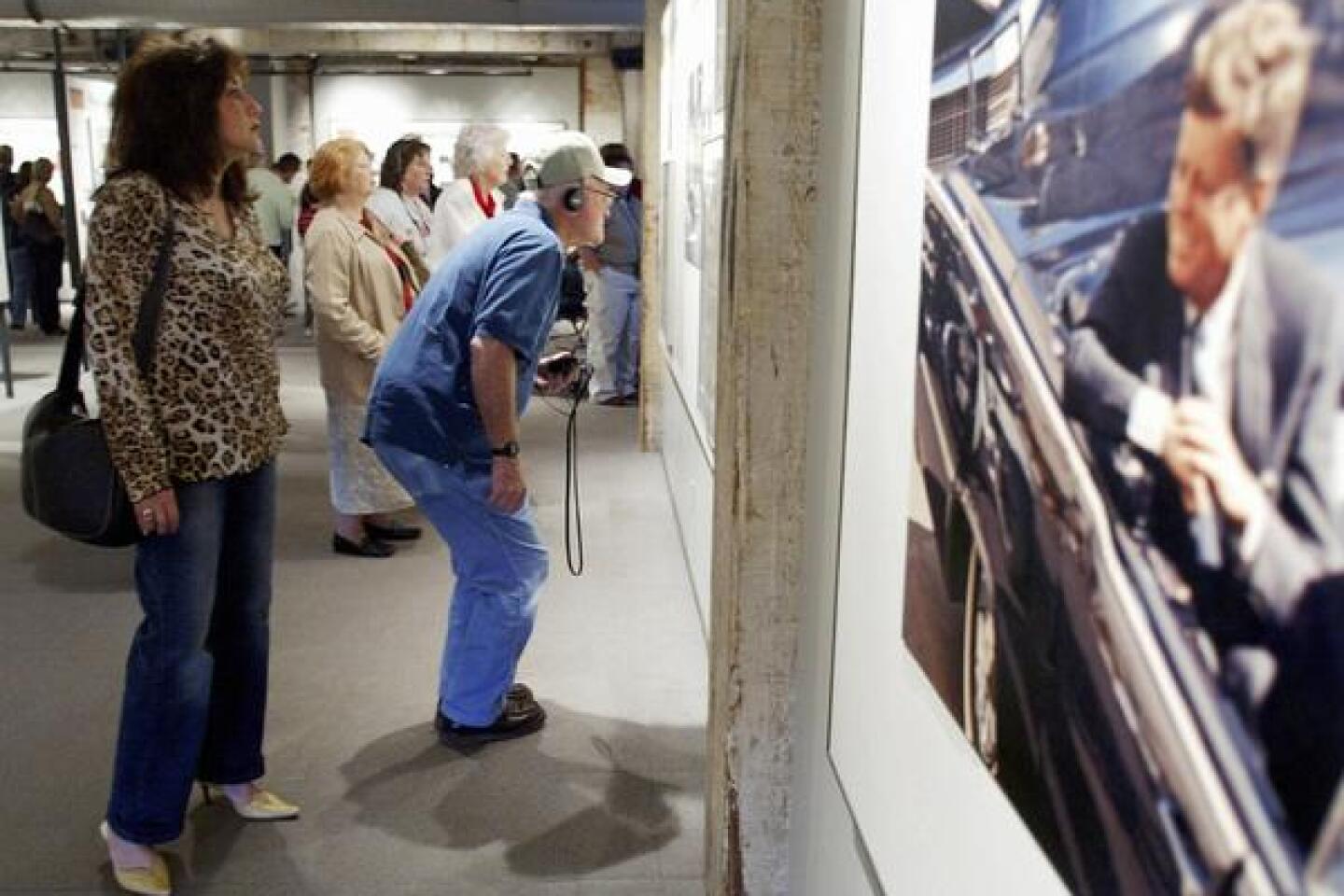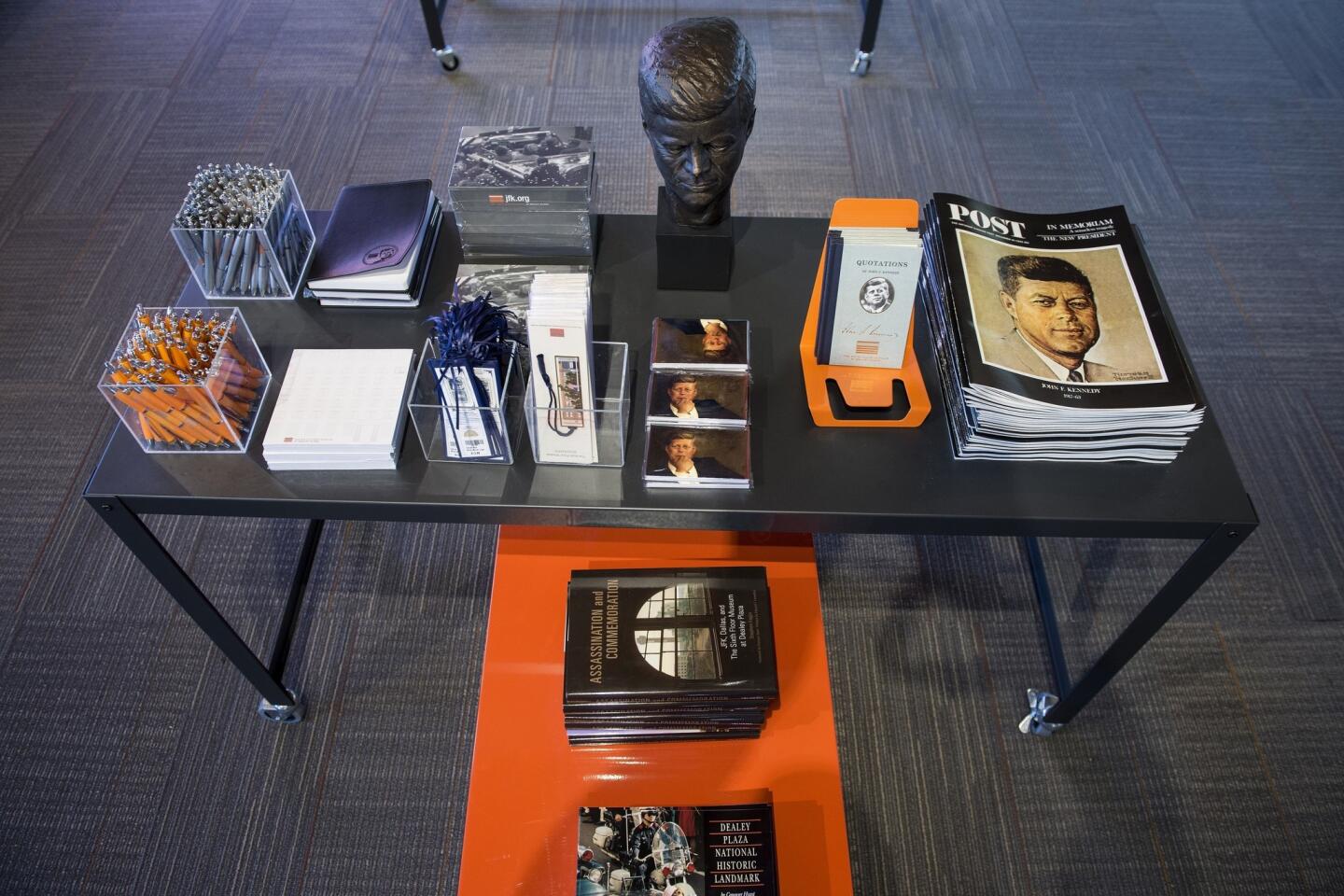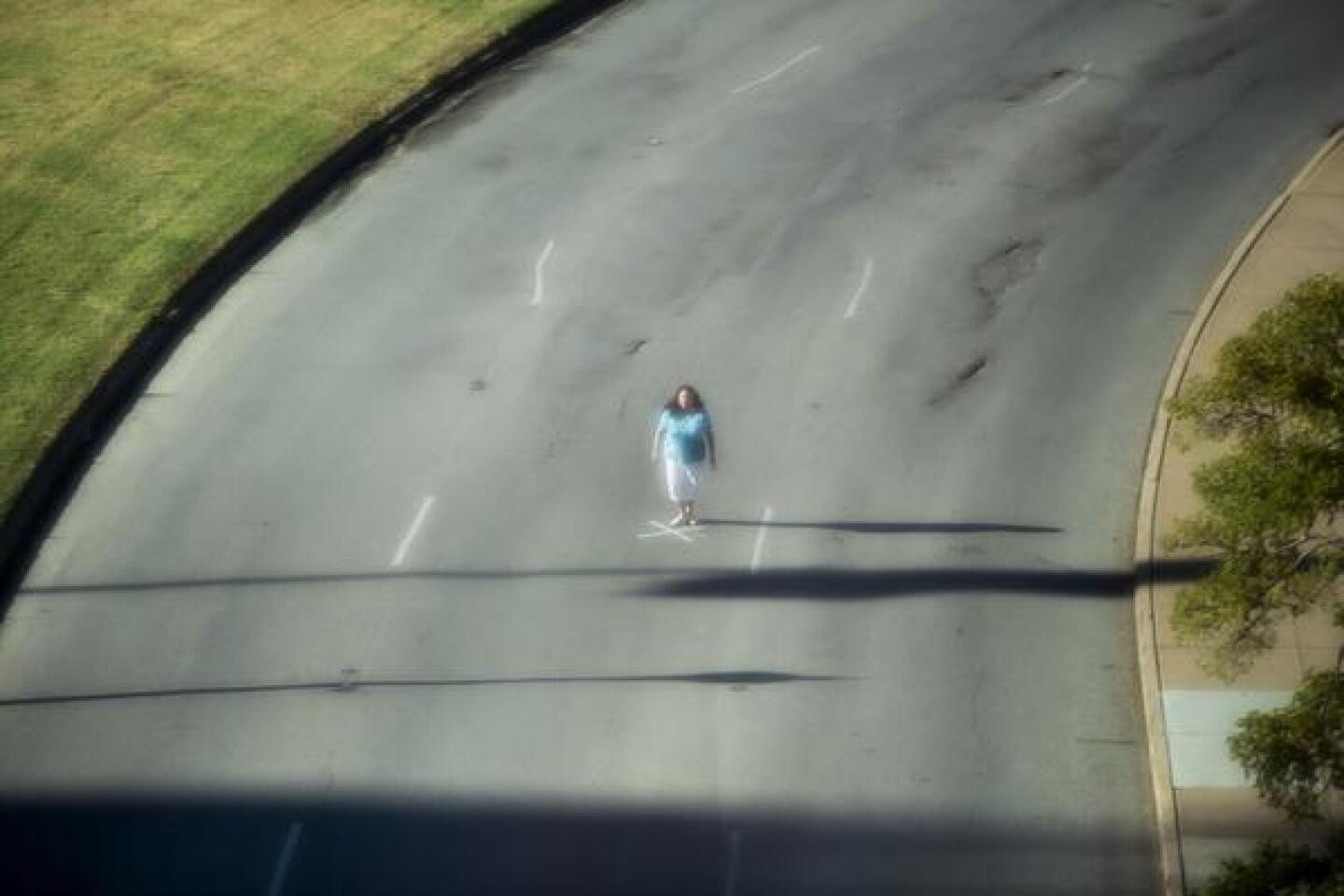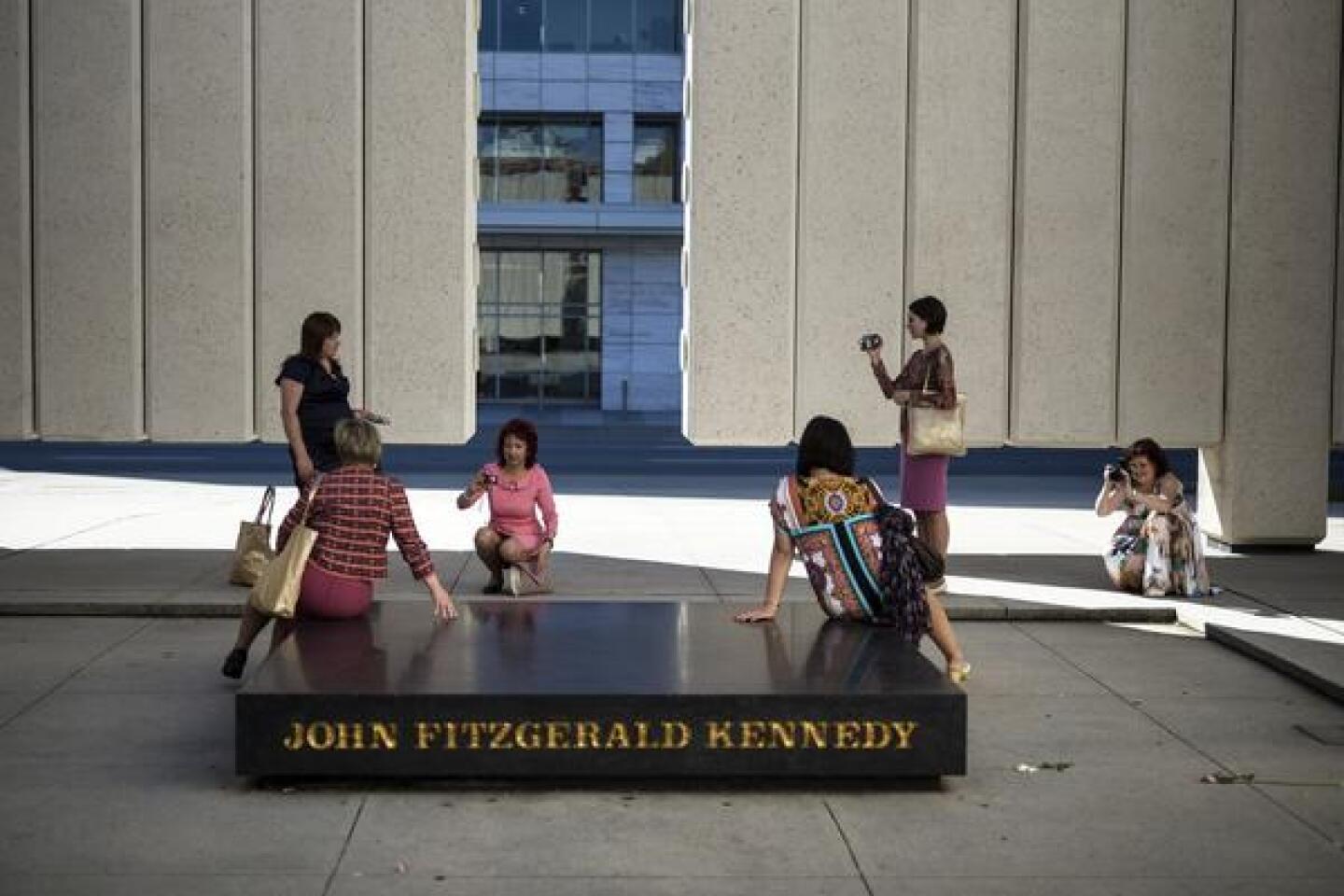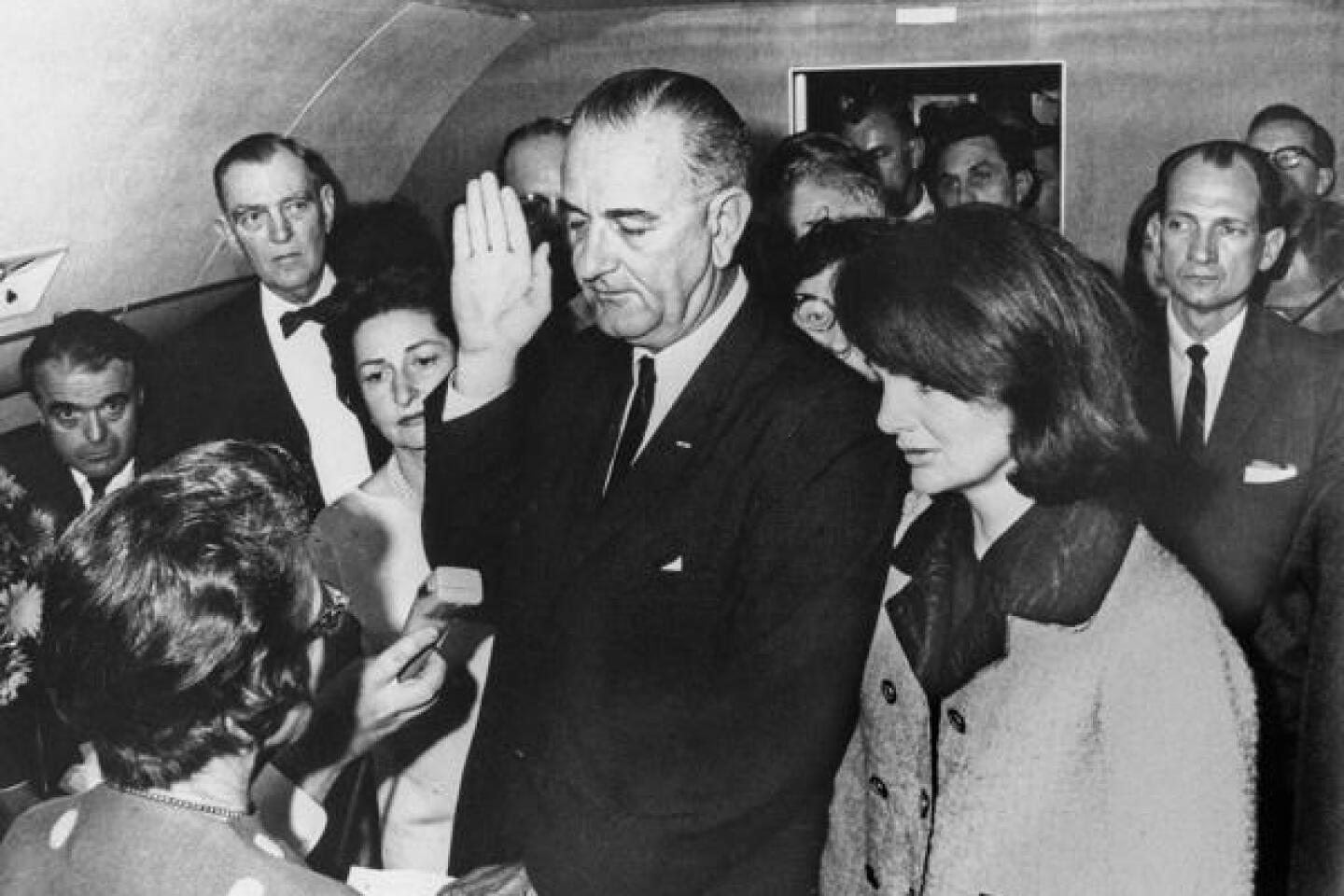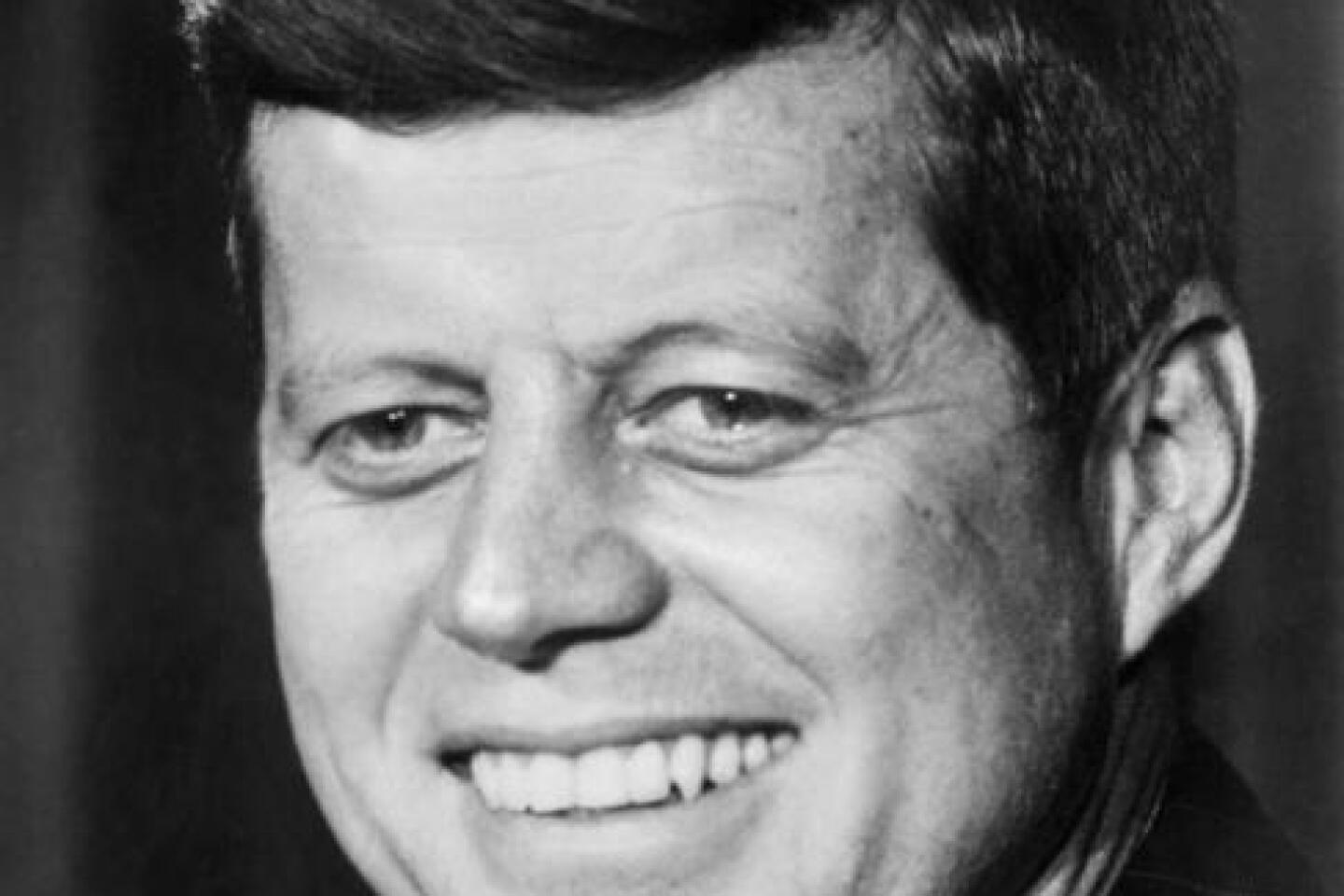Dallas’ Sixth Floor Museum gives bigger picture of JFK assassination
- Share via
DALLAS — It’s a site, and sight, both eerie and fascinating.
Peering through thick glass, I see a collection of scuffed boxes up against a corner window, the sniper’s nest from which Lee Harvey Oswald is said to have shot President John F. Kennedy. The boxes, in the Sixth Floor Museum at Dealey Plaza in Dallas, are duplicates of the originals, stacked precisely as they appear in crime scene photographs from Nov. 22, 1963.
Nearby, people look out an adjacent window onto Dealey Plaza, where two large, white Xs in the roadway mark where Kennedy was shot. Those Xs, like many other landmarks in this city, are attractions; tourists wait for a break in the traffic, then dash into the street, stand on one and quickly pose for a souvenir photo.
The Xs, like those boxes, will likely be scuffed by visitors here to mark Nov. 22, the 50th anniversary of Kennedy’s assassination.
This museum is unlike any other in the United States, and maybe the world. At Ford’s Theatre in Washington, D.C, where President Lincoln was shot in 1865, plays and musicals are still performed. In New Delhi, a modest shrine in the garden marks where Mahatma Gandhi was killed outside his home in 1948.
The sixth floor of the former Texas School Book Depository building takes visitors back to one of the darkest days of the 20th century. Kennedy’s death has become a unifying point of reference for Americans; most people of a certain age can tell you immediately where they were when they heard the news.
I was 7 years old, a second-grader in Hayward, Calif., when the older sister of a friend told me the news. I sat in disbelief. The events that weekend became the catalyst for my career in journalism and communications, and later motivated me to compile the recently published book “November 22, 1963: Reflections on the Life, Assassination, and Legacy of John F. Kennedy.”
Fifty years later, I can still hear the dirges and muffled drumbeats of the funeral procession from the White House to the Capitol that Sunday afternoon. Less than an hour earlier, I had watched on live television as Jack Ruby shot accused assassin Oswald.
Those iconic images, captured on film and in photographs on display in the Sixth Floor Museum, recall the emotions that gripped America.
Exiting the elevator, I stepped onto the wooden planks of the former warehouse. The first exhibits take visitors back to the early 1960s with album covers and books such as “The Feminine Mystique,” by Betty Friedan, as well as JFK campaign posters.
The video of the Kennedy-Richard Nixon debates makes it clear why Kennedy was dubbed the nation’s “first television president.” His confidence and charm far overshadow the gruff, serious demeanor of then-Vice President Nixon. As expected, there are images of Kennedy’s inaugural speech and his declaration that “the torch has been passed to a new generation of Americans,” and the clarion call to “Ask not what your country can do for you; ask what you can do for your country” that inspired countless young people to careers in public service.
Highlights of his presidency, such as the Bay of Pigs fiasco in April 1961 and the Cuban missile crisis in October 1962, demonstrate distinctions in presidential decision-making and show how Kennedy, the youngest president ever elected, grew into the job as the leader of the free world.
These engaging images led me to the next series of exhibits and the stark reminder of why I was here.
The smallest details contribute to the bigger picture. I lingered over a photocopy of Oswald’s application to work at the book depository building. Nearby, there is an image of Dallas Police Chief Jesse Curry holding a news conference urging the public’s cooperation during the president’s visit. Less than a month earlier, the city had hosted Adlai Stevenson, America’s ambassador to the United Nations, who was spat upon and accosted by Kennedy opponents.
Some of those opponents, who believed Kennedy and his administration were “soft on communism,” bought a full-page advertisement in the Nov. 22 Dallas Morning News. I stopped and skimmed a framed copy of the ad headlined “WELCOME MR. KENNEDY TO DALLAS,” noting that the city “rejected your philosophy and policies in 1960 and will do so again in 1964 — even more emphatically than before.” Ted Dealey, the newspaper’s publisher and son of the man for whom Dealey Plaza is named, was a staunch Kennedy opponent and approved the ad.
Kennedy saw the ad that morning in his hotel suite in Fort Worth. He was disgusted, remarking to his wife, Jacqueline, “Oh, you know, we’re heading into nut country today.”
Images in the next several panels belie the photos of tragedy that museum visitors know are ahead. We see the president and the first lady, who is wearing the pink suit and matching pillbox hat, being greeted at Dallas’ Love Field. They shake hands with well-wishers along a fence, then enter the Lincoln limousine with Texas Gov. John Connally and his wife, Nellie. Along the 9 1/2-mile route to the Dallas Trade Mart for the president’s luncheon speech, onlookers wave flags and shout to the Kennedys. At one point, Kennedy tells the driver, Secret Service agent William Greer, to stop so he can greet a group of Catholic nuns.
The mood is celebratory.
“The people of Dallas had turned out in overwhelming numbers and had given the president a vibrant and warm welcome,” Curry would write in his memoir six years later. “For a brief moment, I almost started to relax.”
The next several panels show the limousine coming under gunfire in Dealey Plaza. Still photos from the film taken by clothing manufacturer Abraham Zapruder chronicle the six seconds that some believe changed history:
•The president grabbing his neck after being wounded, as Connally turns around in agony after he, too, realizes he has been hit.
• The infamous frame 313 showing blood and brain matter erupting from Kennedy’s head as the fatal bullet strikes.
• Jacqueline Kennedy crawling on the trunk of the vehicle to retrieve a piece of her husband’s shattered skull.
• Secret Service agent Clint Hill leaping onto the trunk to protect her as the vehicle speeds toward Parkland Memorial Hospital.
In an interview in 2012 for my JFK book, Hill told me, “Any agent would have done the same thing. I happened to be one.... None of the other agents had a chance. I did have that opportunity, but it was too late.”
Hill’s words — and the next exhibits — elicit “What if?” questions I have pondered hundreds of times. There is Kennedy’s place setting of china from the head table at the Trade Mart and a program for a fundraising dinner scheduled that evening in Austin.
A few yards away, photographs of vigils in world capitals — Dakar, Senegal; London; Buenos Aires; Mumbai, India; Tokyo; and Bern, Switzerland — seek to illustrate the impact of Kennedy’s assassination outside the United States. That aftershock is reinforced by an image of a bookshelf with some of the hundred and hundreds of books written about JFK.
Nearby is a photo of Kennedy with a quote from historian and author Daniel J. Boorstin that captures one important aspect of the legacy of the 35th president: “To those who have the misfortune to die young, history assigns the role of inspirer.”
As I entered the elevator taking me down six floors and back to 2013, I pondered those words and Kennedy’s life and legacy. Fifty years after his death at age 46, he still inspires young people.
Molly Kimmel, a 16-year-old Michigan girl, is one. “He was extremely good looking,” she said in a note to me after reading my book about a president who died before even her parents were born. “He was the first president born in the 20th century, and he stood for a new generation of change for the 1960s. He was also extremely relatable to everyone, he was ‘hip’ and modern and used television and photography to capture people, which had never been seen in a presidential candidate before.”
Intelligence and inspiration, it seems, manifest themselves in many ways, sometimes by influencing politics and public policy but no less so by cultivating hearts and minds.
More to Read
Sign up for The Wild
We’ll help you find the best places to hike, bike and run, as well as the perfect silent spots for meditation and yoga.
You may occasionally receive promotional content from the Los Angeles Times.
